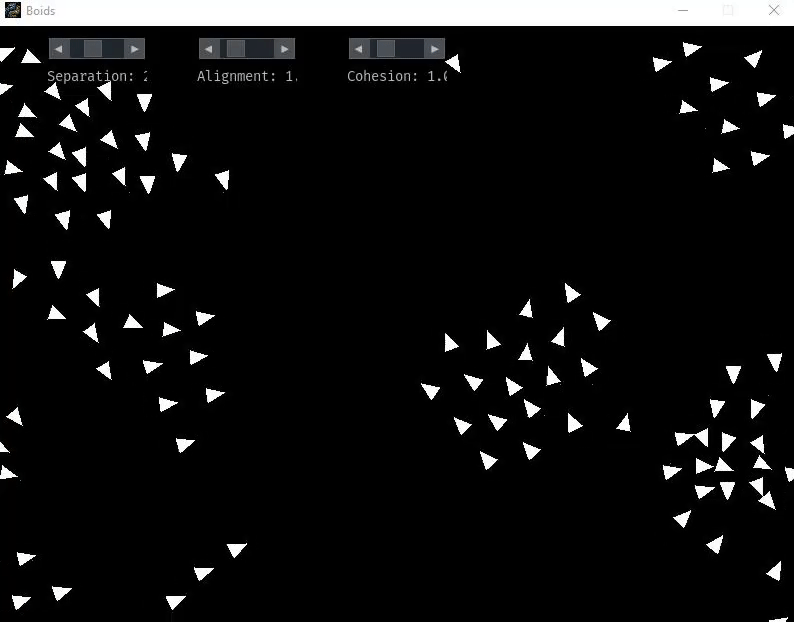https://github.com/sverrenystad/boids-in-python
A boids simulation made in python with dynamic scales for adjusting runtime alignment, cohesion and separation forces
https://github.com/sverrenystad/boids-in-python
boids-simulation python
Last synced: 3 months ago
JSON representation
A boids simulation made in python with dynamic scales for adjusting runtime alignment, cohesion and separation forces
- Host: GitHub
- URL: https://github.com/sverrenystad/boids-in-python
- Owner: SverreNystad
- Created: 2023-10-19T22:06:36.000Z (over 1 year ago)
- Default Branch: main
- Last Pushed: 2023-12-17T15:52:55.000Z (over 1 year ago)
- Last Synced: 2025-04-06T08:47:11.867Z (3 months ago)
- Topics: boids-simulation, python
- Language: Python
- Homepage:
- Size: 1.82 MB
- Stars: 2
- Watchers: 1
- Forks: 2
- Open Issues: 0
-
Metadata Files:
- Readme: README.md
Awesome Lists containing this project
README
# Boid Simulation

## Description
This Python script simulates the complex behavior of a flock of birds, known as "Boids", using a few simple rules: separation, alignment, and cohesion, along with wandering behavior. The simulation utilizes the Pygame library for visualization and runs in real-time, displaying Boids as they interact with each other according to the defined parameters and behaviors.
One can change the three different forces during simulation by adjusting the sliders.
[](https://gyazo.com/f37a7d8c3102542ca7804a0fe605fd69)
## Dependencies
- Python 3.x
- Pygame
- Pygame GUI
## Installation
To run the simulation, you need to install the dependencies. You can do this by running the following command in your terminal:
```bash
pip install -r requirements.txt
```
## Usage
After installing the dependencies, you can run the simulation by executing the script in your terminal:
```bash
python boids.py
```
This will open a new window where you can see the Boids moving around the screen.
## Configuration
The script contains several parameters that you can tweak to change the behavior of the Boids:
- `NUM_BOIDS`: The number of Boids in the simulation.
- `BOID_SIZE`: The size of each Boid on the screen.
- `SPEED`: The speed at which Boids move.
- `MAX_FORCE`: The maximum force that can be applied to a Boid for it to change direction.
- `BOID_FRICTION`: The resistance the Boids experience, akin to friction, slowing them down over time.
- `WANDER_RADIUS`: The radius within which a Boid will wander randomly.
- `SEPARATION`: The degree to which Boids try to maintain distance from one another.
- `SEPARATION_RADIUS`: The radius within which Boids will begin to experience separation force.
- `ALIGNMENT`: The degree to which Boids try to align themselves with the average direction of nearby Boids.
- `ALIGNMENT_RADIUS`: The radius within which Boids will begin to experience alignment force.
- `COHESION`: The degree to which Boids try to move towards the average position of nearby Boids.
- `COHESION_RADIUS`: The radius within which Boids will begin to experience cohesion force.
Feel free to experiment with these values to observe different behaviors in the Boid flock.
## How it Works
- The script initializes a Pygame window and populates it with a number of Boid objects.
- Each Boid has properties that determine how it interacts with others:
- **Separation**: Boids try to avoid crowding their neighbors.
- **Alignment**: Boids try to align their direction with the average heading of their neighbors.
- **Cohesion**: Boids try to move towards the average position of their neighbors.
- These forces are calculated for each Boid, and a resultant force changes the Boid's direction.
- A "wandering" behavior is also implemented to make the Boid's movement more natural and less uniform.
- Boids are drawn on the screen as simple triangles, the orientation of which depends on their current velocity.
## Key Components
- `class Simulation`: Handles the initialization and running of the simulation, managing events, and updating the Pygame screen.
- `class PhysicsObject`: An abstract class representing an object following simple physics laws.
- `class Boid(PhysicsObject)`: Represents a Boid, inheriting from PhysicsObject, and containing methods for each behavioral rule (separation, alignment, cohesion, and wandering).
## Exiting the Simulation
You can exit the simulation by closing the Pygame window or pressing Ctrl+C in the terminal.
## License
This project is licensed under the MIT License. See the LICENSE file for details.
## Acknowledgements
- Craig Reynolds for the original concept of Boids.
- The course assistant in TDT4137 Kognitive arkitekturer that the setup.